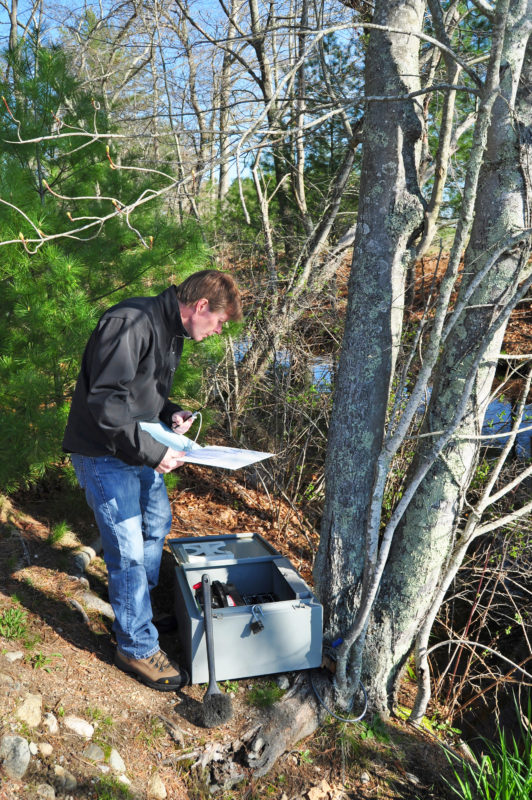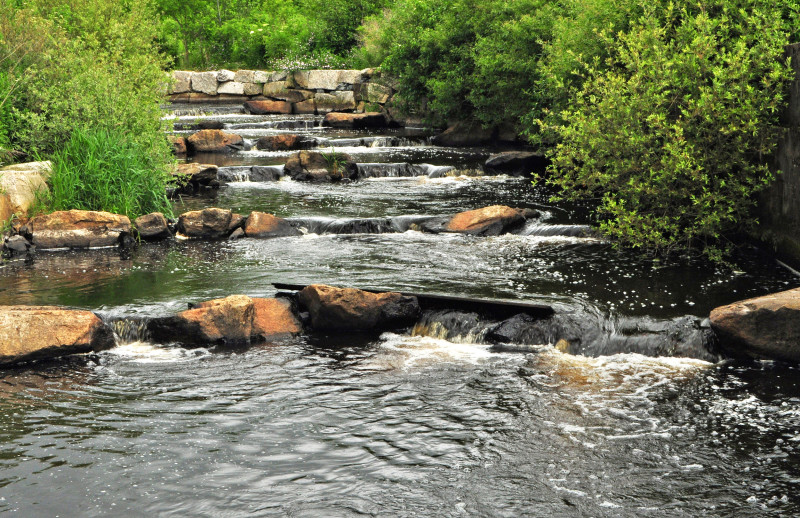River herring numbers are up in some Bay waterways – but there’s more work to do
Population counts of river herring were up in three of Buzzards Bay’s most important rivers — the Agawam, Acushnet, and Mattapoisett Rivers — during spring 2019, according to data collected by the Coalition, the Massachusetts Division of Marine Fisheries (DMF), and other local groups. These small, silvery fish form an important link in the food chain, and these increases are encouraging. But rising numbers don’t mean that the work to protect river herring has ended.

Tony Williams, the Coalition’s Director of Monitoring Programs, checks an electronic fish counter along the Acushnet River.
Centuries ago, Buzzards Bay’s rivers ran silver with herring every spring. These fish once appeared in the millions as they swam upstream from the Atlantic Ocean to reproduce in fresh water. Yet centuries of human impacts have dwindled river herring numbers to just a fraction of these historical counts. Dams, pollution, climate change, and overfishing have decreased herring populations by up to 98 percent, spelling bad news for the Bay’s ecosystems. Without enough herring swimming up the Bay’s rivers each spring, sportfish and birds have less food to eat.
Every year the Coalition sets up electronic herring counters on the Acushnet River, the Agawam River, the Wankinco River, the Sippican River, and Cedar Lake, in Falmouth’s Rands Harbor. A dedicated group of volunteers makes this work possible, checking the fish counters every day between March and June and recording the number of river herring that have passed through in the last 24 hours. In addition, the DMF tracks herring migrating up the Monument River at the Cape Cod Canal, and Alewives Anonymous tracks herring in the Mattapoisett River.
Because it has the longest dataset, the Mattapoisett River serves as our local benchmark for tracking river herring populations. In 1921, when monitoring on the Mattapoisett River began, 1.85 million river herring were counted. This year, Alewives Anonymous counted 18,156 herring in the river, up from 5,241 in 2018. This is the first increase in the Mattapoisett River herring population since 2014; however, this count still represents less than one percent of the 1921 count.
Upticks in river herring numbers do suggest that local efforts to preserve river herring are working — and should continue. The Coalition’s electronic herring counters registered 16,819 herring in the Acushnet River this spring. That’s a record high since the Coalition improved fish passage at The Sawmill dam site in 2007, making the Acushnet River the only river that’s unbroken from Buzzards Bay to its headwaters. On a local scale, projects to eliminate blockages and reopen rivers to fish passage are clearly making an enormous difference for river herring and other migratory fish.

This innovative fishway at The Sawmill uses carefully placed boulders that mimic the river’s natural form and allow river herring to migrate upstream, resulting in a significant increase in herring in the Acushnet River.
River herring numbers also spiked in the Agawam River, where the Coalition counted 102,105 fish, up from 63,010 last year. The cause of this spike is harder to pinpoint, but many local and state-wide efforts may have helped. These include the state’s 2005 moratorium on harvesting or selling river herring, improvements in the health of local waterways, and restrictions on fishermen who use gear that accidentally captures herring as bycatch.
At the same time, herring populations in other Bay rivers show that these changes are not universal. Herring population counts dropped in the Wankinco River, Sippican River, and at Cedar Lake— all rivers with significant remaining barriers to fish passage.
The increases in some herring populations are hopeful news for the future of this foundation species. Yet even successful population numbers are just a drop in the bucket compared to what these fish once were. The Coalition will continue to work to restore our local rivers and protect river herring, giving these important fish a chance of returning to their former abundance.